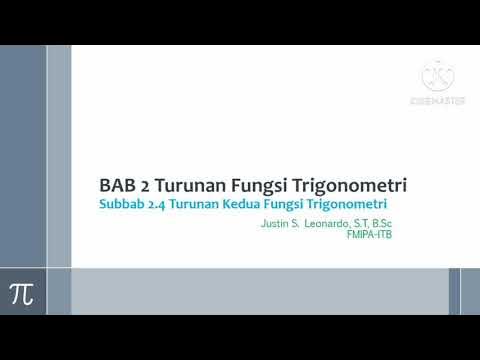APLIKASI TURUNAN TRIGONOMETRI | APLIKASI TURUNAN TRIGONOMETRI KELAS XII IPA
Summary
TLDRIn this educational video, the speaker explains advanced applications of trigonometric derivatives for 12th-grade students. The content covers determining intervals of increasing or decreasing functions, finding tangents, and analyzing concavity and points of inflection. Key mathematical concepts such as the first and second derivatives, trigonometric identities, and their practical uses are discussed in detail. The speaker includes various examples to illustrate the process, making it easier for viewers to understand the application of these concepts in solving real-world problems. The video aims to help students grasp these important trigonometric principles for their studies.
Takeaways
- 😀 The video discusses the application of derivatives in trigonometric functions for Grade 12 students.
- 😀 The focus is on understanding the concepts of increasing and decreasing functions, where the first derivative is used to determine intervals of increase or decrease.
- 😀 To find when a function is increasing, the first derivative must be greater than zero, while for decreasing functions, the first derivative should be less than zero.
- 😀 A maximum or minimum point can be found by setting the first derivative equal to zero and analyzing its behavior.
- 😀 The equation of the tangent line is derived using the formula: y - y1 = m(x - x1), where m is the slope calculated from the derivative at the point of tangency.
- 😀 The second derivative helps in determining concavity: if it is positive, the function is concave up, and if negative, it is concave down.
- 😀 An inflection point occurs where the second derivative equals zero, indicating a change in concavity from up to down or vice versa.
- 😀 The video uses specific examples to demonstrate these concepts, including solving for intervals of increase and decrease using inequalities and critical points.
- 😀 For maximum or minimum values in trigonometric functions, key angles like 0°, 90°, and 180° are often used, as they are significant in trigonometry.
- 😀 The video emphasizes the importance of knowing special angles (such as 45°, 90°, and 180°) to simplify calculations in trigonometric derivatives.
- 😀 The video concludes by encouraging viewers to practice solving problems related to derivatives and trigonometry, with a reminder to like and subscribe for more educational content.
Q & A
What is the first application of trigonometric derivatives discussed in the video?
-The first application discussed is determining intervals where a function is increasing or decreasing. If the first derivative is greater than zero, the function is increasing; if the first derivative is less than zero, the function is decreasing.
How do you determine the maximum or minimum points using trigonometric derivatives?
-To find maximum or minimum points, the first derivative should be equal to zero. These points are also referred to as stationary points.
What is the method for finding the equation of a tangent line to a function?
-To find the equation of a tangent line, you need two components: the point of tangency (x1, y1) and the slope (m). The equation is given by y - y1 = m(x - x1), where m is the derivative of the function at the point of tangency.
What does concavity refer to, and how is it determined using derivatives?
-Concavity refers to the direction of the curve. If the second derivative is positive, the function is concave up; if the second derivative is negative, the function is concave down.
What is a point of inflection, and how is it found?
-A point of inflection is where the function changes concavity, from concave up to concave down or vice versa. It occurs when the second derivative equals zero.
What is the role of special angles in trigonometric derivative problems?
-Special angles (such as 0°, 30°, 45°, 60°, and 90°) are important for calculating values of trigonometric functions like sine and cosine, which are needed to solve derivative problems involving trigonometric functions.
How can you identify when a function is increasing or decreasing on a specific interval?
-To determine if a function is increasing or decreasing on a specific interval, calculate the first derivative. If the first derivative is positive in the interval, the function is increasing; if negative, the function is decreasing.
What is the method to determine whether a function is concave up or down?
-To determine whether a function is concave up or down, calculate the second derivative. If the second derivative is positive, the function is concave up; if negative, it is concave down.
In the video, how is the process of finding stationary points explained?
-Stationary points are found by setting the first derivative equal to zero and solving for x. These points represent potential maximum or minimum values.
How does the instructor explain solving problems involving derivative inequalities?
-For derivative inequalities, the instructor explains that you need to evaluate when the derivative is greater than or less than zero, which determines the behavior of the function (increasing or decreasing) on certain intervals.
Outlines

Этот раздел доступен только подписчикам платных тарифов. Пожалуйста, перейдите на платный тариф для доступа.
Перейти на платный тарифMindmap

Этот раздел доступен только подписчикам платных тарифов. Пожалуйста, перейдите на платный тариф для доступа.
Перейти на платный тарифKeywords

Этот раздел доступен только подписчикам платных тарифов. Пожалуйста, перейдите на платный тариф для доступа.
Перейти на платный тарифHighlights

Этот раздел доступен только подписчикам платных тарифов. Пожалуйста, перейдите на платный тариф для доступа.
Перейти на платный тарифTranscripts

Этот раздел доступен только подписчикам платных тарифов. Пожалуйста, перейдите на платный тариф для доступа.
Перейти на платный тарифПосмотреть больше похожих видео

Persamaan Garis Singgung dan Garis Normal Fungsi Trigonometri - Aplikasi Turunan Fungsi Trigonometri

Matematika tingkat lanjut kelas XII (12) SMA /MA Kurikulum merdeka @GUcilchaNEL1964

Turunan Fungsi Trigonometri 4: Turunan Kedua Fungsi Trigonometri

(Part 2) Nilai Fungsi Trigonometri || Matematika Tingkat Lanjut Kelas XI

Section 6.2 - Trig integrals and substitution - Part 1

Turunanfungsi Trigonometri Bag 1
5.0 / 5 (0 votes)
